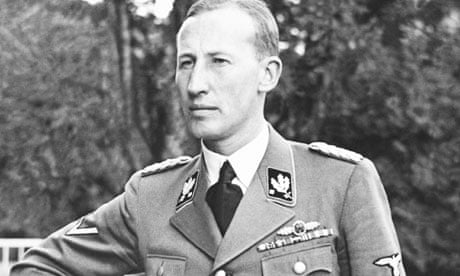 |
| The gatehouse at Auschwitz-Birkenau, taken from outside of the camp. Photo courtesy of the author. |
The Holocaust is, in the West, the best known of genocides
and mass slaughters. We all know the images: Hitler ranting before a crowd of
adoring worshipers; Nazi soldiers goose-stepping in perfect sync before their
Führer; the destruction of Jewish shops, homes, and synagogues on Kristallnacht; the cutting of pious Jews’
beards and payot in front of laughing
Germans; Jews forced to walk a bridge over the “Aryan” Chłodna Street in the
Warsaw Ghetto; the mass shootings by the Einsatzgruppen
in the East; the loading of trains; the frightened boy of the Warsaw Ghetto raising his hands with a Nazi pointing a gun at him; the Auschwitz-Birkenau gatehouse (pictured above);
Hungarian Jews waiting to be gassed in the little wood of Birkenau; and the mountains of corpses in Dachau, Buchenwald, and Bergen-Belsen. Anne Frank is
perhaps the most famous diarist of the 20th century. We think of
Hermann Göring alternately giggling and looking exasperated at the Nuremberg
trials and Adolf Eichmann smirking in his glass booth in Jerusalem.
In other words, the Holocaust is incredibly well known:
perhaps not in all of its details, and certainly not in the complexities of Nazi
policies that brought it about, but definitely in a general sense as a
nightmarish historical event that is well-nigh impossible to look at for too
long. The footage of Belsen’s liberation is practically unwatchable, and images
of the piled up hair at Auschwitz are disgusting beyond all reason. The Holocaust
came to American living rooms in the late 1970s with the miniseries Holocaust and again in the early 1990s
with the Academy Award-winning Schindler’s
List. Holocaust films continue to be churned out: The Pianist, The Grey Zone, Son of Saul, and so on. The United
States Holocaust Memorial Museum in Washington, D.C. is considered a must-see, and
is swamped by visitors from every corner of the globe. The museum at
Auschwitz-Birkenau is a destination for many travelers in Europe.
So, yes, most people know about the Holocaust in a general
sense, and perhaps even more than that. But what is it about the Holocaust that
grips us? Yes, it was horrible, but so were the Gulag camps under Stalinism,
the killing fields of Pol Pot’s Cambodia, and the pits of Srebrenica; the
deportation trains that took Armenians to the desert where they starved to
death; the hacking of limbs with machetes in Rwanda. There is something about
the Holocaust, though, that seems to particularly frighten us. Hitler’s name is
thrown about willy-nilly, and in some sense he has almost become a comical
figure: an absurdity whose name is a punchline to Internet jokes, a raving
lunatic in a bunker who loses his
mind when he discovers that Taylor Swift left Calvin Harris (I’m making this
up, but you get the idea). And yet, there is a reason why it is his name that is thrown around, and not that of Joseph Stalin or Mao Zedong. He menaces us with his frightful gaze and his
ferocious hatred that drove millions into a bloodthirsty frenzy. His
single-minded determination to wage war on Europe, and the world, and to
destroy every single Jew is haunting in a way that the policies of Stalin and
Mao are not. Stalin and Mao were vicious, brutal murderers who left tens of
millions dead, but neither embarked upon a mission to extinguish an entire
people. Adolf Hitler did, and he did so while being the legitimately popular leader of his country. And I posit that it has been through laughter and
mockery that many of us have tried to come to grips with the horror.
There is something singularly and uniquely disturbing about
Hitler. The same is true of the Nazis. I think that many people recognize this
singularity on some level, even if on a subconscious one. This short essay will
explain why the Holocaust was indeed unique and delineate the reasons why. By “Holocaust”
in this context, I am referring to the state-sponsored systematic extermination
of the Jews of Europe by the National Socialists under the rule of Adolf Hitler
from the years 1941-45. I am leaving out the Gypsies, Poles, homosexuals,
Jehovah’s Witnesses, and other groups that were also persecuted and murdered by
the Nazis because the Nazis, at the end of the day, only desired to kill the Jews down to the last man, woman, and
child. Gypsy policy, though extremely murderous, was wildly inconsistent; the
Poles experienced an attempt at cultural genocide and were subject to ruthless ethnic cleansing and enslavement, but were mostly able to live their lives
so long as they did not resist the Nazis; homosexuals and Jehovah’s Witnesses,
among other groups, were persecuted in frightful ways but were ultimately not subject
to systematic and total extermination. Only the Jews were. This is a fact.
It has been popular in recent years to conflate the fate of
the Jews with the others, and to condemn the focus on the fate of the Jews as
being somehow supremacist: the Jews are butting to the head of the victims’
queue and disregarding others who were brutalized by the Nazis. This has also
become a trend in countries in Eastern Europe, such as Poland, where Nazi
savagery against native populations is equated with that against the Jews. As
horrifically as the Poles were treated (nearly three million non-Jewish Poles were killed),
there was no policy to eradicate every Polish individual. Polish language, yes;
Polish heritage and history, yes; the Polish intelligentsia and elite, yes; but
not every Pole.
I would argue that what happened to the Poles was genocide. Indeed, what the Nazis planned for the Slavs to their east in general was genocidal on a mind-boggling scale. Some 31 million were to be deported, starved to death, or murdered; the balance, about 14 million "Germanizable" people, were to be used as helots for German settler-farmers. These slaves would not be taught the language or the heritage of their forefathers, but rather pidgin German so that they would be able to communicate with their German masters but know their place in society. Eventually, if the Nazis had succeeded, these nations and cultures, and the languages they spoke, would have been only a memory. Thankfully, this did not happen. The annihilation of the Jews, however, did. The only line the Jews were at the head of was the National Socialist chopping block. It was a priority of the Nazis' war to destroy the Jews, and while their destruction was originally to occur after the war, Hitler ultimately decided that he could not wait. The other peoples of the eastern lands could. The Nazis did not want the Jews to serve them and recognize them as masters; they wanted the Jews out of Germany, out of Europe, and, finally, extinguished from the face of the earth. Jews could not even exist in this capacity in a Nazi-dominated Europe. And, of course, there was no such thing as a "Germanizable" Jew, so there was no escape from the noose whatsoever. What happened to the Jews, therefore, was unique, not only in the context of the Second World War, but also compared to other genocides we have seen before or since.
I would argue that what happened to the Poles was genocide. Indeed, what the Nazis planned for the Slavs to their east in general was genocidal on a mind-boggling scale. Some 31 million were to be deported, starved to death, or murdered; the balance, about 14 million "Germanizable" people, were to be used as helots for German settler-farmers. These slaves would not be taught the language or the heritage of their forefathers, but rather pidgin German so that they would be able to communicate with their German masters but know their place in society. Eventually, if the Nazis had succeeded, these nations and cultures, and the languages they spoke, would have been only a memory. Thankfully, this did not happen. The annihilation of the Jews, however, did. The only line the Jews were at the head of was the National Socialist chopping block. It was a priority of the Nazis' war to destroy the Jews, and while their destruction was originally to occur after the war, Hitler ultimately decided that he could not wait. The other peoples of the eastern lands could. The Nazis did not want the Jews to serve them and recognize them as masters; they wanted the Jews out of Germany, out of Europe, and, finally, extinguished from the face of the earth. Jews could not even exist in this capacity in a Nazi-dominated Europe. And, of course, there was no such thing as a "Germanizable" Jew, so there was no escape from the noose whatsoever. What happened to the Jews, therefore, was unique, not only in the context of the Second World War, but also compared to other genocides we have seen before or since.
Take, for instance, the National Socialist conception of the
Jew. The Jews were not inferior beings who should serve as slaves or be thrown
down to the bottom of some caste system. Yes, the Jews experienced a sort of
apartheid in the period before their mass annihilation (1933-41) in the Reich,
but that is not the time period in question which, as mentioned above, is
1941-45, the years of extermination. Jews were, rather, seen as the Weltfeind (world enemy): responsible for
Germany’s defeat in the First World War; responsible for the alleged immoral liberalism
and democracy of the Weimar Republic; responsible for the socialists who were
seen as the standard bearers of Weimar; responsible for the Bolshevik
Revolution in Russia in 1917, and the subsequent mass murder experienced under
Soviet control; the puppeteers of the capitalists in London and Washington; the
controllers of the global media and the international banking system; and a
race obsessed with the destruction of the “Aryans” by any means whatsoever,
whether it be capitalism or communism. Hitler’s obsessive hatred with the Jews
consumed him until the day he died: his desire to murder them was a burning
thirst that drove him insane with bloodlust until the very end. This was simply
not the case with other groups, which were mostly viewed through the lens of dismissive contempt, not a pathological, all-encompassing hatred.
It is not an exaggeration to contend, as I do, that the
Second World War was, for Hitler, a war against the Jews. His invasion of the
Low Countries and France in 1940 was meant only to protect his rear before
lashing out at the Soviet Union. Hitler’s war against the British was lackadaisical
at best, and he was not particularly motivated to destroy the British or their
Empire, which he admired. For him, the real war was in the East, against the
Bolsheviks, because to his mind, Bolsheviks were Jews and Jews Bolsheviks, and
they were spinning a web from their lair in Moscow to ensnare Germany and other
countries of “good race” in Europe. They had to be destroyed. This, plus the
desire for living space (Lebensraum),
was Hitler’s motivation for launching his war in the East.
Upon the invasion of the Soviet
Union, Hitler unleashed his Einsatzgruppen,
mobile death squads that shot some two million Jews into pits. Further
west, Jews were ghettoized and, beginning in spring 1942, sent to their deaths
in gas chambers. The Weltfeind, this
pernicious race that fed off the blood of the “Aryans” and sought to undermine
the nations of “pure racial stock” in Europe, was finally being destroyed. To make sure that this "world enemy" knew the score, they were often ritually humiliated before they were murdered: the aforementioned beard-cutting, forced to sing the praises of Lenin, forced to rip their beloved Torah to pieces and spit on it, forced to dance in front of their tormentors, forced to urinate and defecate in each other's mouths. Men,
women, and children were pursued in so-called "Jew hunts" in remote villages, in hidden
bunkers, in attics, in farmsteads, and in forests: no one could escape. In
Poland, helping a Jew meant death, for yourself and perhaps for your entire
family. Heinrich Himmler, the head of the SS, flew to Finland to implore that
country’s leader to send his 2,000 Jews to their deaths. To Finland. What possible dispute could Jews in such a far-flung place
have with Germany?
This totality of the Holocaust, in which every single Jew was to be eradicated from the face of the earth
(if perhaps after a short delay due to the need for his or her slave labor), is
one of the factors that separates it from other genocides. While Srebrenica was
reminiscent of the Einsatzgruppen murders
in the Soviet Union and while the Armenians were drowned and left to die in the
desert, there was no attempt to murder every
last one of them. They were to be struck at in a ferocious way to “learn a
lesson” or to “get out of the way,” or to be driven relentlessly away from
border areas because they were seen as potential saboteurs and traitors (this
was especially the case with the Armenians, who the Turks believed were in
cahoots with the Russians during the First World War). But it was never in
Slobodan Milosevic’s purview, for example, to murder all Bosniaks. On the other
hand, the Nazis swept Europe from east to west, and north to south, combing
urban environments and rural ones, forcing innocent children like Anne Frank to
cower in hidden annexes like fugitive criminals on the lam. This was a
continent-wide genocide, unlimited in time or space, against an “enemy” that
had, literally, done nothing to Germany or the German people, except to serve
it proudly during the First World War and to sing its praises before, during, and after
it, and to enrich its culture with beautiful literature and music and
earth-shattering scientific discoveries. It did not matter. Nothing could save
them. Not baptism, not patriotism, not economic benefit, not the most fervent of
Heil Hitlers: they were sentenced to
die for the crime of having been born. And the children too, because what was a
Jewish child but a Jew in inchoate form? They, too, had to be shot into the
pits and shoved into the gas chambers. Many were thrown into the ovens alive:
this was one of Josef Mengele’s favorite pastimes.
The industrial nature of the
Holocaust also separates it from other genocides. The assembly line of
deportation, gassing, and cremation, and the economic exploitation of the
dead: their money and valuables stolen, their hair shorn for upholstery,
their clothes sent to citizens of Germany, their golden crowns ripped out of
their mouths and melted down and deposited into special bank accounts, their
ashes spread to fertilize flower gardens and crop fields; this is also unique.
The Nazis used the train system, which was so essential in cultural and economic
progression in European and other contexts, to ship millions to their deaths.
They sent Jews from nearly every country of Europe to abattoirs that were
awaiting them in Auschwitz-Birkenau, Bełżec, Treblinka, Sobibór, Majdanek, and
Chełmno, places that were specifically designed to murder them. Indeed, the
death camp itself is a unique facet of the Holocaust: a site whose purpose was to kill the most amount of people in the most efficient way possible. As murderous as the
Soviet Gulag was, they were not intended solely or primarily to kill their
prisoners, but to exploit their labor and/or to "re-educate" them.
Jews were not simply the victims
of on-the-spur, localized brutalities such as looting or pogroms or even mass murders, although that happened too. On the other hand, in many
instances they were shipped from remote places like Salonika, Greece; Oslo,
Norway; and even the Channel Islands, only to be gassed in Nazi-occupied
Poland. The measured and calculated way this was done, the logistics involved, is testament to the Nazi determination at total extermination of the Jews. The crematoria complexes in Auschwitz-Birkenau were in some (negative) sense
an architectural marvel: gas chambers and crematoria all conveniently housed in
one building. The efficiency and dehumanized manner of it all is chilling and
borderline incomprehensible.
The Jews and Germans were not
enemies, except in the Nazi imagination. They had no border disputes or
historical enmity. These were not tribal groupings fighting over an oasis, a
river, or a mountain fastness. While obviously not explaining away the
genocides of any ethnic group anywhere, in instances such as the Armenian and
Bosnian genocides, the mass murders had their roots in either ethnic strife or
border disputes. The Rwandan genocide
occurred in the context of a civil war between a government led by Hutu and a
rebel group largely composed of Tutsi. In the case of the Holocaust, the Nazis
came down on the Jews like a bat out of hell for no fathomable reason
whatsoever, outside of Hitlerian conspiracism and obsession. The Jews did not
have a running dispute with the Germans; they had not fought any wars with
them; and most of the Nazis’ victims were not even German or German-speaking
Jews. The Jews were just going about their lives, in whatever they did, whether
it be peddling wares in a shtetl in
Eastern Poland, or mending boots in Kraków, or running a department store in
Prague, when all of a sudden they were overwhelmed by the deluge.
The Nazis descended upon foreign
Jewish villages and towns, and cities with high Jewish populations, and wantonly
slaughtered them. There couldn’t even be the pretext of their having been
disloyal citizens. Hitler was essentially making the Jews of the world pay for
what he deemed the major crime of the Jews of Germany: the German defeat in the
First World War. This, of course, was absurd and existed only in the feverish
imaginations of radical anti-Semites. Regardless, the Jews of not just Germany,
but of all of Europe, were to pay for this imaginary crime. And when the
Germans came, it was like a tsunami. There was no historical precedent for the
Nazi onslaught in Eastern Europe, not even during the darkest days of the tsars.
Jews had always been able to appease their oppressors through the gifting of
money or other concessions; this was not the case this time. There were
instances where the Jews acted in such a traditional fashion, presenting gold
to Nazi soldiers in the hopes and expectations that this would be their
deliverance; instead, the Germans took the gold and shot them in the streets
anyway. In the pithy words of Holocaust historian Raul HIlberg, “The
missionaries of Christianity had said in effect to the Jews: 'You may not live
among us as Jews.' The secular rulers who followed them from the late Middle
Ages then decided: 'You may not live among us,' and the Nazis finally decreed: ‘You
may not live.’”
The reason why more Jews were not
murdered during the Holocaust and that “only” two-thirds of European Jews lost
their lives was because the Nazis lost the war. If Hitler had won the war in
Europe, and therefore had had the leisure to deal with the Jews as he pleased, it is hard to imagine that
that percentage would not have shot up to virtually 100%. If Erwin Rommel had
succeeded in North Africa and the German army was able to push into Palestine and
beyond, the Jews of the Middle East would have likewise been extinguished.
Hitler’s war against the Jews was infinite in both scope and conception because
he believed that the German race, and indeed the human race, could not thrive
so long as the Jews existed. There is simply no parallel to this level of ambition in any other
genocide or campaign of mass murder. This “redemptive anti-Semitism,” as coined
by historian Saul Friedländer, was the alpha and omega of Adolf Hitler’s
worldview, until he put a gun to his temple under the streets of Berlin in
April 1945. It was redemptive in that he felt the messianic need to eradicate
the Jews so that the “Aryan” race could reach its potential. The communists in
the East were seen as identical to the Jews. This, combined with sneering
contempt for the Slavs, is why the German war in the Soviet Union was so
remorselessly brutal. In Hitler’s last will and testament, he railed against
the “world destroyer”: the Jew.
In sum: it was the totality, the
continent-wide nature of the genocide, the obsessive determination to kill all
Jews in Nazi-occupied Europe, the conception of the Jew not just as the “Other”
or inferior but rather as literally the world enemy who prevented other peoples
from thriving, the industrial nature of the genocide, and the complete lack of
any dispute whatsoever between the murderers and the murdered that makes the
Holocaust an event unique in history.
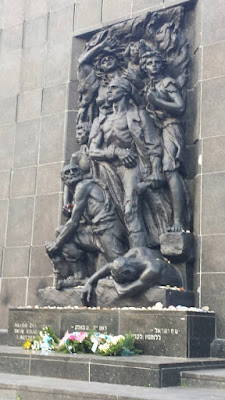
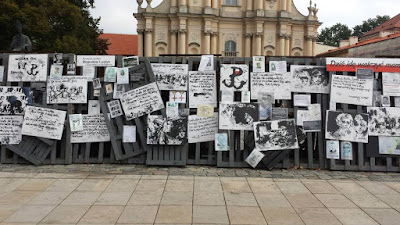
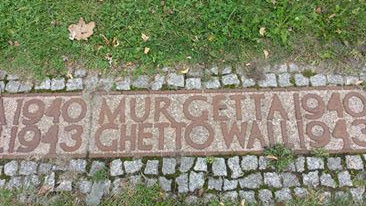
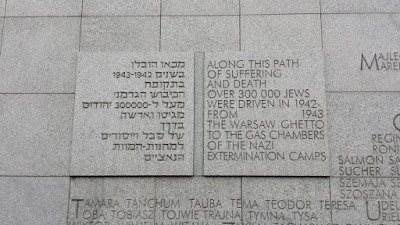
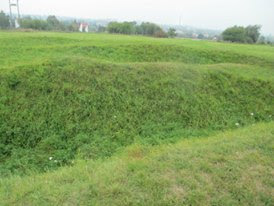

.jpg)


.jpg)
